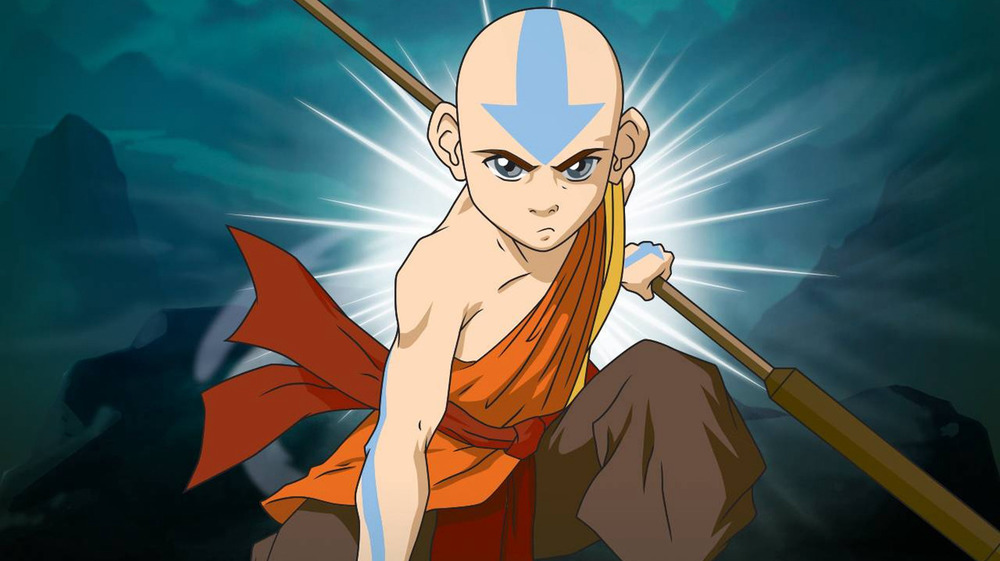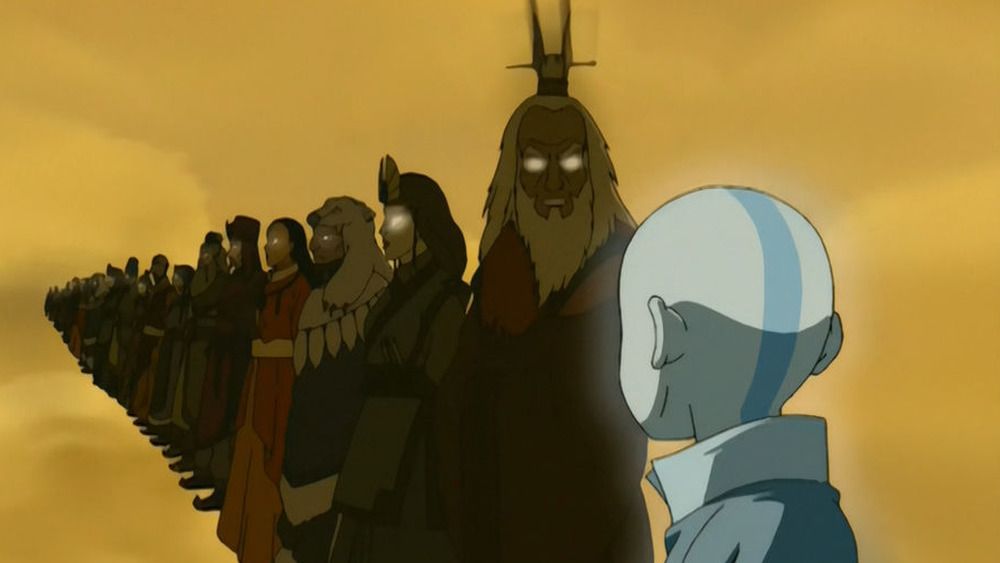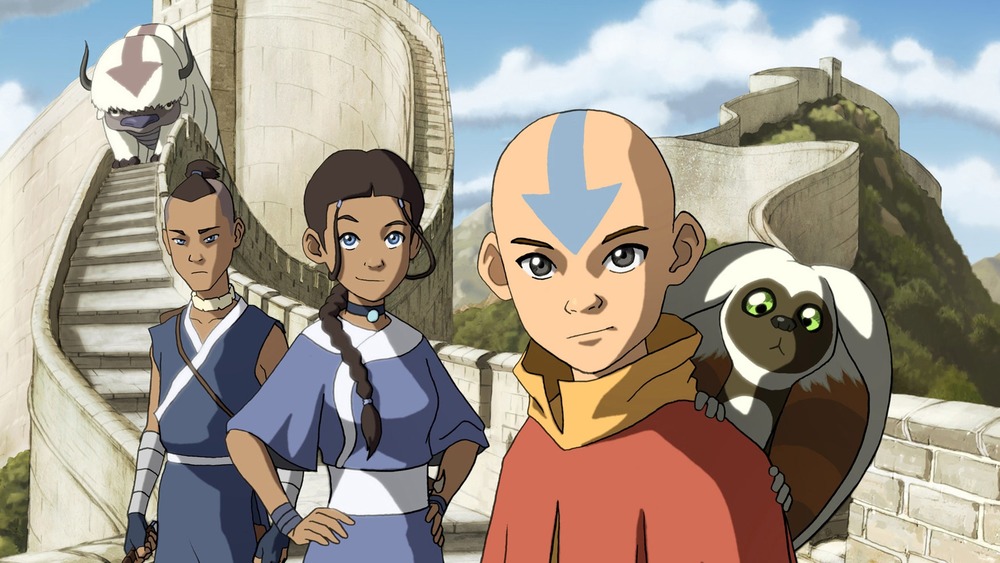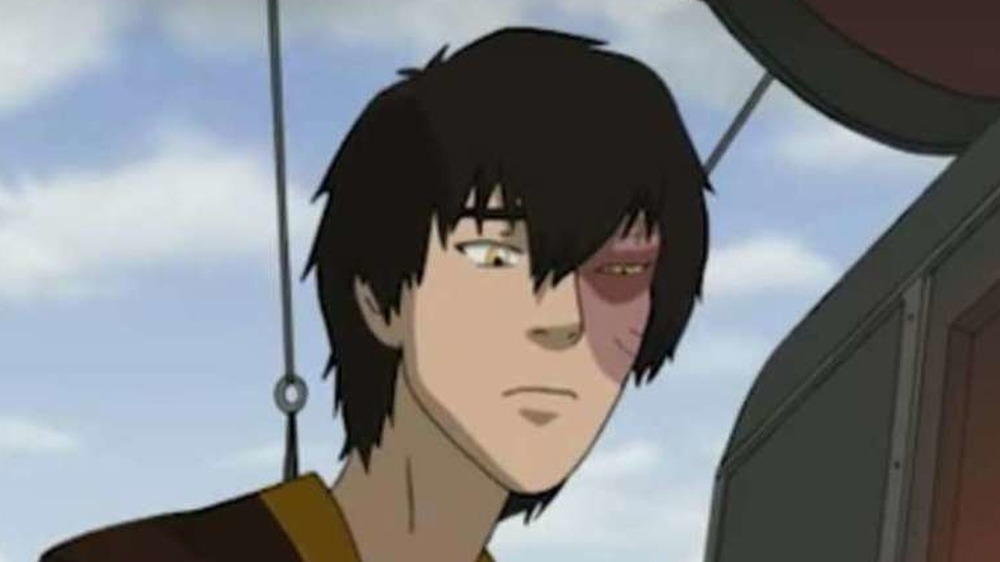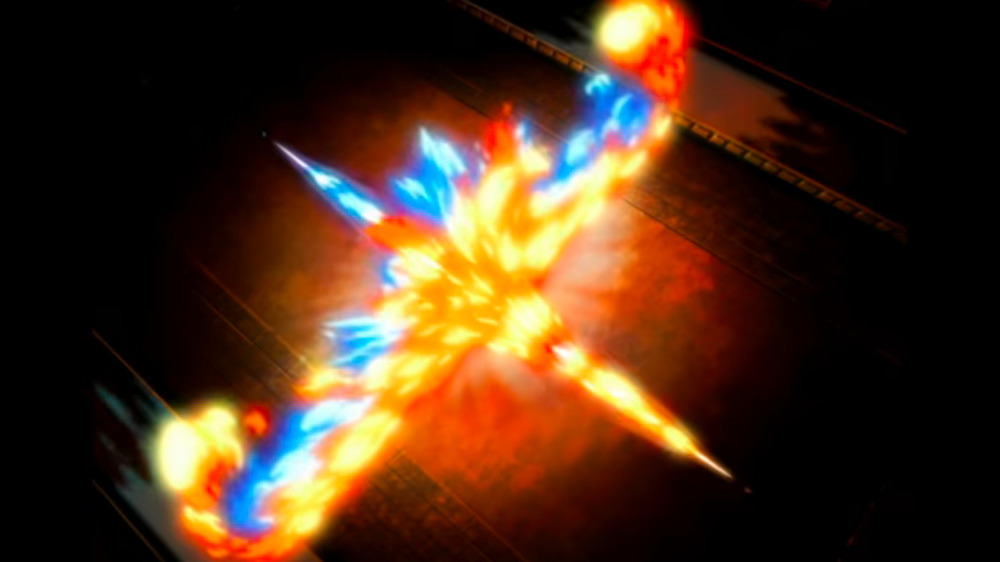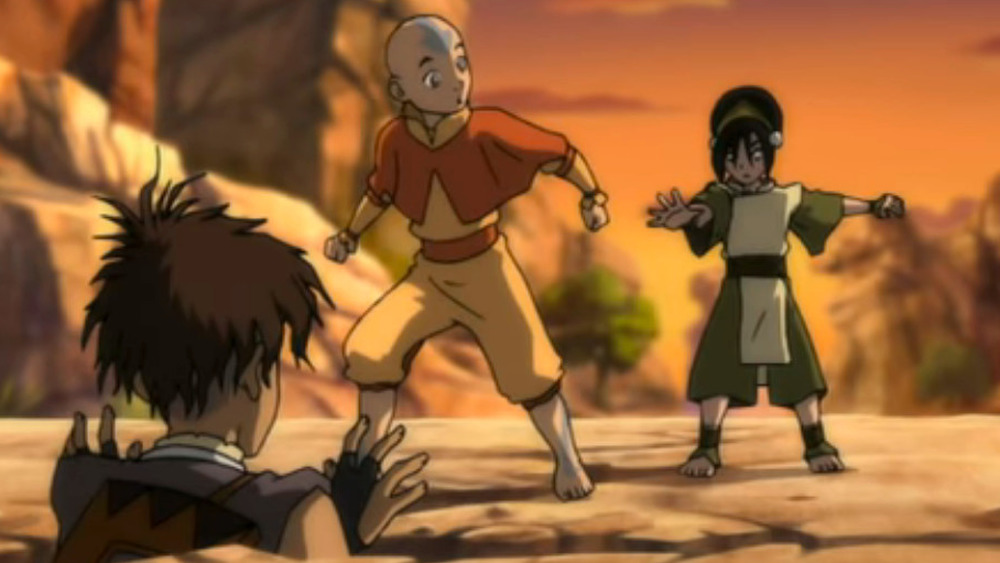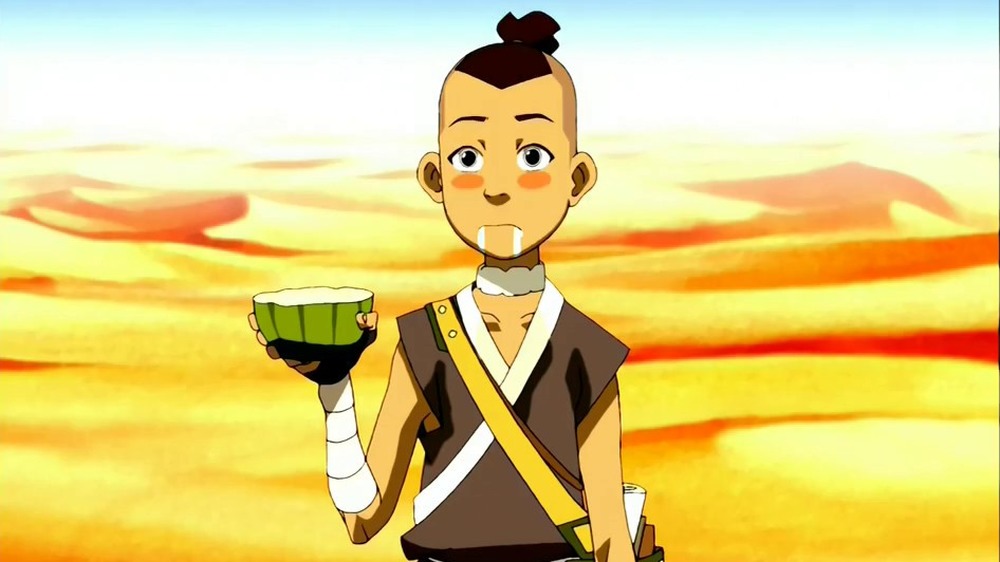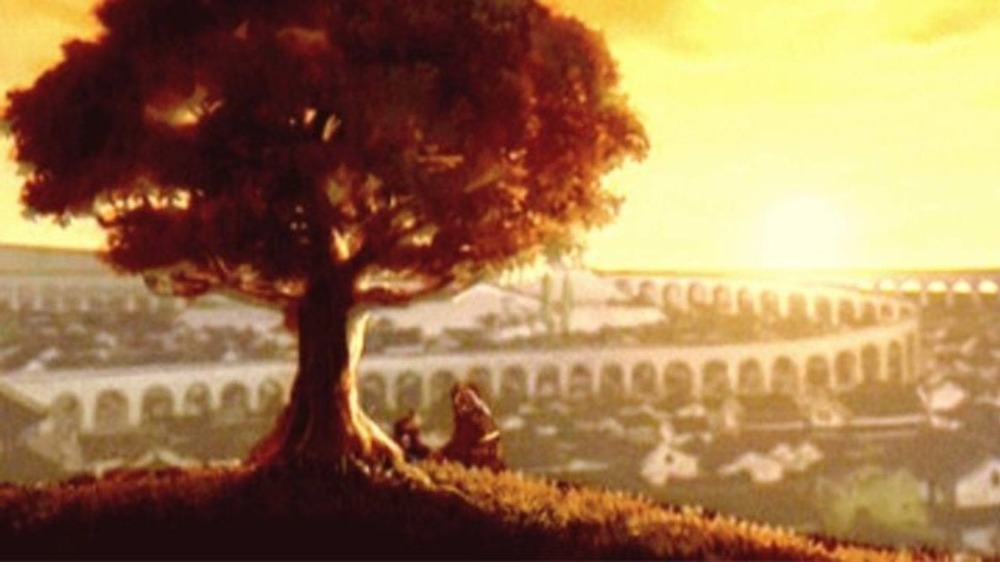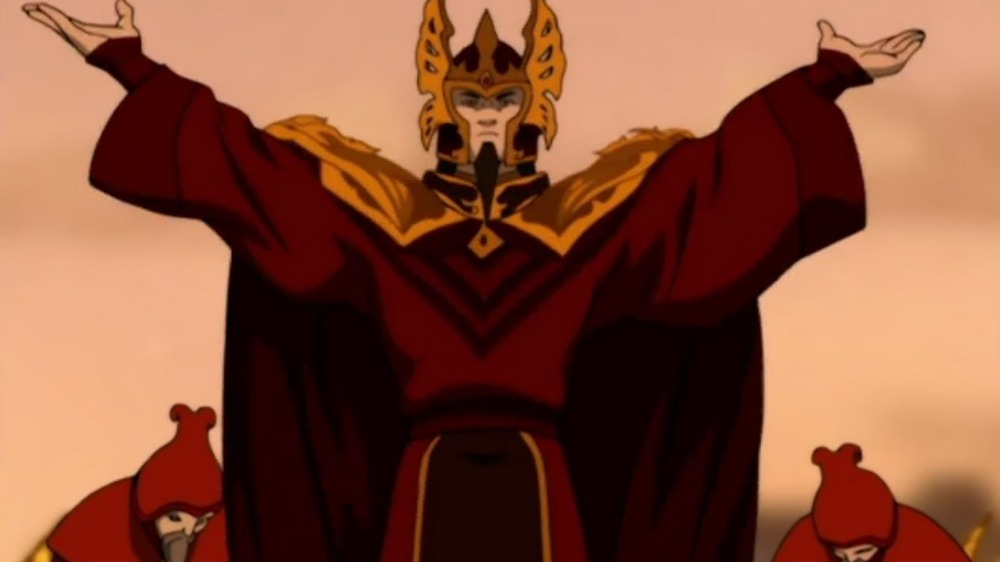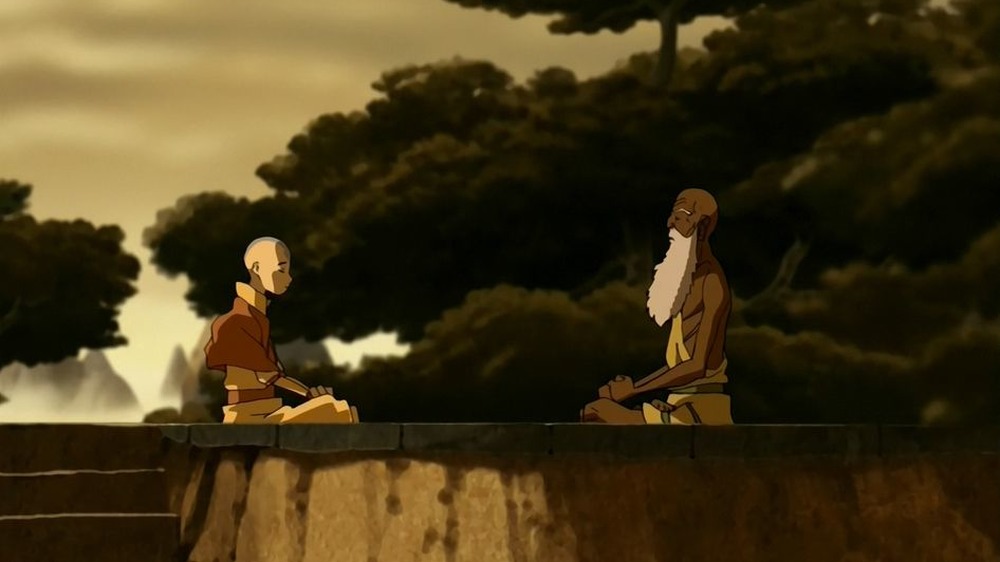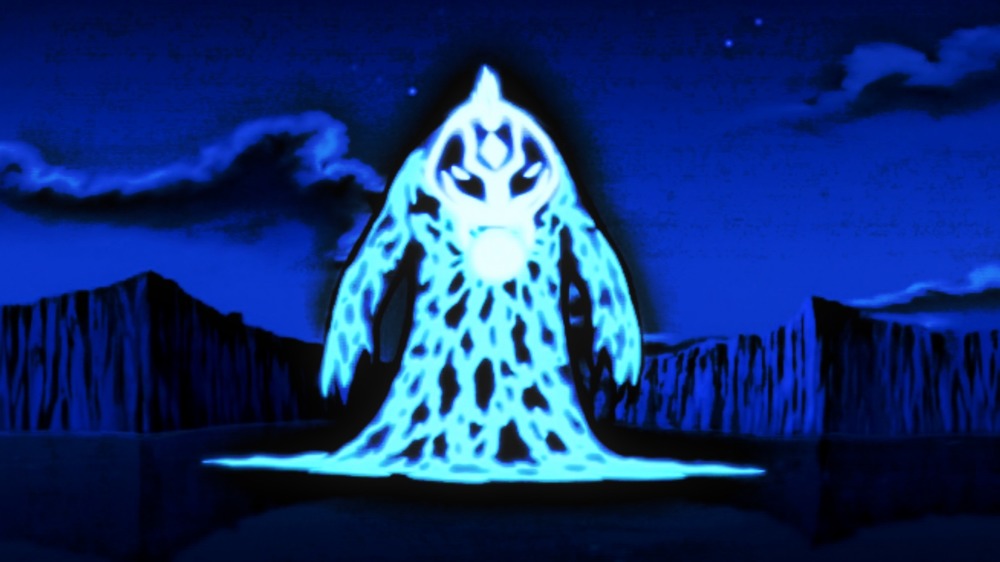Why Avatar The Last Airbender Is The Best Animated Show Ever
Nickelodeon has been home to many beloved children's cartoons, including SpongeBob SquarePants, Fairly OddParents, and Rugrats, but none of them have had the same cultural impact as Avatar: The Last Airbender.
This more action-heavy Nicktoon premiered on February 21st, 2005, taking viewers to a fantasy world where certain individuals can "bend" the elements of their respective region — water, earth, fire, or air. As the nefarious Fire Nation wages war against the other three kingdoms, two teenage siblings from the Southern Water Tribe (Sokka and Katara) stumble upon a young airbender named Aang, who has been frozen in ice for almost 100 years, and subsequently revive him. Aang also just so happens to be the Avatar, a legendary figure responsible for maintaining harmony between the four kingdoms, and must master all four elements in order to defeat the Fire Lord and restore balance to the world.
While this premise doesn't sound too dissimilar to those of numerous other fantasy shows, Avatar: The Last Airbender became a massive success for Nickelodeon, spawning two subsequent seasons and a sequel series called The Legend of Korra, which takes place several decades later and focuses on a whole new cast of characters. Here's a look at all the reasons why Avatar: The Last Airbender is the best animated series of all time. This article contains major spoilers.
Very subversive
While its rough plot synopsis makes Avatar: The Last Airbender sound like a generic fantasy show, the series actually does an excellent job at subverting and re-contextualizing many overused genre tropes, specifically the idea of a "Chosen One" that was popularized by franchises like Star Wars and The Matrix.
In fact, the concept of the Avatar is already a clever subversion of the Chosen One because it brings in the idea of reincarnation. Whenever an Avatar dies, another is reincarnated into another bender, as dictated by the cyclic order of fire, air, water, and earth. For example, the Avatar before Aang was a firebender named Roku, which is why Fire Lord Sozin wiped out most of the Air Nomads and ultimately kickstarted the Hundred Year War shortly after Aang accidentally froze himself in time.
Each Avatar can also activate a defense mechanism called "the Avatar State," which allows them to access the skills and knowledge of all previous Avatars during increasingly difficult situations, but even that has limits. If an Avatar is killed while in the Avatar State, the reincarnation cycle will break and the Avatar will cease to exist. To quote Avatar Roku, "In the Avatar State, you're at your most powerful, but you are also at your most vulnerable."
Terrific supporting cast
Aang is a very unique and engaging protagonist in his own right, yet Avatar: The Last Airbender is one of the few shows where the supporting cast is just as (if not more) interesting than the main character.
Katara, the show's supporting female lead, showcases a very motherly demeanor throughout the series, which mostly stems from the traumatic loss of her mother at a very young age. Sokka, the most prevalent comic relief character of the main cast, is not a waterbender like his sister but has proven time and time again that he is great warrior and an even better tactician. Toph, an earthbender who is not introduced until early into the second season, is a young blind girl who can see through earthbending and, as a result, is even more of a force to be reckoned with.
Even the show's two main animal sidekicks are fascinating characters. Aang's loyal sky bison companion Appa serves not only as the primary form of transportation for Team Avatar but also as Aang's spirit guide. The winged lemur Momo, on the other hand, is comparatively more playful, but still has a special connection to both Aang and Appa. These and other characters help develop Aang into the lovable young hero that we know him as today.
Fantastic redemption arc
Many fans of Avatar: The Last Airbender will agree that Prince Zuko of the Fire Nation is the best character on the show because of how well his character develops over time. When we meet Zuko in the show's pilot, he comes off as an angsty, ponytail-wearing bad guy who is obsessed with finding the Avatar. But as the series reveals more about his past, Zuko easily becomes the most sympathetic character on the show, to the point where his eventual redemption feels completely earned.
A major factor in Zuko's development is the ongoing dynamic with his wise and caring paternal figure, Uncle Iroh, who accompanies Zuko on his journey to hunt down the Avatar. While Zuko was essentially brought up by a fascist dictator for a large portion of his life, Iroh always saw some good within his nephew and hoped that he could one day discover it for himself. This extremely heartwarming dynamic is a major reason why these two characters are generally considered fan favorites.
Amazing animation
It's impossible to talk about an animated series such as Avatar: The Last Airbender without also discussing its, well, animation. While viewers of the show have long debated whether Avatar is indeed an example of the Japanese animation style known as anime, there is no denying that series creators Michael Dante DiMartino and Bryan Konietzko took plenty of inspiration from anime when developing the show.
Everything about the series' art direction and animation style, from the look of different locales to smaller details such as the arrow tattoo on Aang's forehead, helps bring this seemingly impossible fantasy world to life. The show's fight scenes are also a sight for sore eyes as they incorporate dynamic colors and effective fight choreography in a way that never lets them feel shallow or aimless.
It's also important to mention that many big names in Western animation have gotten their start from working on Avatar: The Last Airbender, such as Dave Filoni (Star Wars: The Clone Wars, Star Wars Rebels) and Ethan Spaulding (Mortal Kombat Legends: Scorpion's Revenge). The influence of this show should not be understated.
Superbly paced trilogy
One could also argue that Avatar: The Last Airbender is one of the greatest trilogies of all time. The series consists of three seasons and each include around 20 episodes, which were all under 30 minutes and usually ranged from okay to downright fantastic. Even "The Great Divide," a standalone episode that's often considered by fans to be the worst in the series, still retains an IMDb user score of 7.0 — and it's currently the lowest-rated episode, whereas the highest-rated ones are closer to a 10.
DiMartino and Konietzko told Polygon in August of 2020 that Avatar: The Last Airbender was always meant to be three seasons. As Susana Polo and Tasha Robinson explain in a Polygon article published three months prior, this approach absolutely works "because so much was planned in advance, they had the ability to lay seeds from the very beginning that let the characters flower organically over time."
Fun for all ages
Avatar: The Last Airbender initially aired as a children's cartoon on Nickelodeon, but that doesn't mean it can't appeal to viewers of all ages.
One example is in the episode "The Desert," when Team Avatar searches for a kidnapped Appa in the Si Wong Desert. After Katara notifies the crew that she doesn't have much water left, Sokka spots a cactus nearby and, along with Momo, drinks from it. Of course, the cactus juice is not what it seems and causes both Sokka and Momo to start hallucinating, which leads to some of the episode's funnier moments.
Specific gags include a scene when Sokka tells Katara that this cactus is "the quenchiest" and another scene when Team Avatar (sans Aang) sees a distant mushroom cloud, to which Sokka says, "It's a giant mushroom. Maybe it's friendly!" These are jokes that both kids and adults can laugh at — and not always for the same reasons.
The emotion is still there
Avatar: The Last Airbender also includes its fair share of emotional moments, especially in the show's latter two seasons, when the main characters are established and the stakes become higher.
One of the best examples is "The Tale of Iroh," which itself is one of six vignettes from a beloved Book Two episode called "The Tales of Ba Sing Se." As the show illustrates, a big reason why Uncle Iroh cares so much about Zuko is because he reminds him of his own son Lu Ten, a soldier for the Fire Nation army who was tragically killed during his father's famous 600-day Siege of Ba Sing Se. "The Tale of Iroh" opens on the story's titular protagonist as he walks into town to purchase a picnic basket for "a special occasion." Along the way, Iroh runs into several city dwellers and helps them out in times of hardship. The tale ends with Iroh making a small shrine for Lu Ten under a large tree on a hill. "Happy birthday, my son," says Iroh. "If only I could have helped you." Moments like these are why Avatar: The Last Airbender continues to stand the test of time.
Surprisingly mature
Despite originally being marketed as a fun children's cartoon on Nickelodeon, Avatar: The Last Airbender often dealt with surprisingly adult themes, such as the effects of war and how it can in turn lead to powerful totalitarian governments like the Fire Nation. In fact, the end of Book Three's mid-season finale "The Day of Black Sun" sees Zuko confront his father, Fire Lord Ozai, about how he is complicit in a the spread of fascism. "Growing up, we were taught that the Fire Nation was the greatest civilization in history, and somehow, the war was our way of sharing our greatness with the rest of the world," he tells him. "What an amazing lie that was."
Zuko also tells his father about how his past exploits have made him rethink his allegiance to the Royal Family, stating that "The people of the world are terrified by the Fire Nation. They don't see our greatness. They hate us, and we deserve it. We've created an era of fear in the world. And if we don't want the world to destroy itself, we need to replace it with an era of peace and kindness." Zuko then confesses to Ozai that he's leaving to help the Avatar, which serves a major step in his road to redemption.
Culturally diverse
The world of Avatar: The Last Airbender takes inspiration from many real-life cultures, specifically those of East and South Asia, yet the show never feels as though it's misusing or disrespecting these cultures.
In her op-ed "'Avatar: The Last Airbender' Imagines a World Free of Whiteness," Maya Phillips of The New York Times explains how the show "managed to embrace all of the above while also conscientiously navigating the tricky minefield of cultural appropriation." Phillips also mentions in her article that the writers were mindful about any potential links between the real world and the show's world — the team even brought in Edwin Zane, the former vice president of the New Media Action Network for Asian-Americans, as "a consultant to make sure questions of cultural sensitivity would be addressed."
Avatar: The Last Airbender is not the first western cartoon to take inspiration from Japanese animation, yet it's easy to see its influence on other anime-esque shows in Western animation such as RWBY and Steven Universe.
Progressively better
While longtime fans of Avatar: The Last Airbender generally consider Book One to be the worst of the three, it still does a decent job of setting the stage for the show's latter two seasons.
In his op-ed "Avatar: The Last Airbender's First Season Is a Little Rocky Because It Was Groundbreaking," James Grebey of Syfy Wire explains that Book One's "More distinct, standalone episodes made for an easier entry point for first-time viewers who may have stumbled upon this new show at random." He elaborates that the subsequent seasons of Avatar: The Last Airbender feel more connected since the stakes are higher and the various pieces introduced in Book One are brought back into the fold.
Grebey also mentions that the show "never forgot the value of an individual episode." Standalone episodes such as "Zuko Alone" and "The Puppetmaster" pause from the epic overarching saga of the series, but they remain great on their own right.
